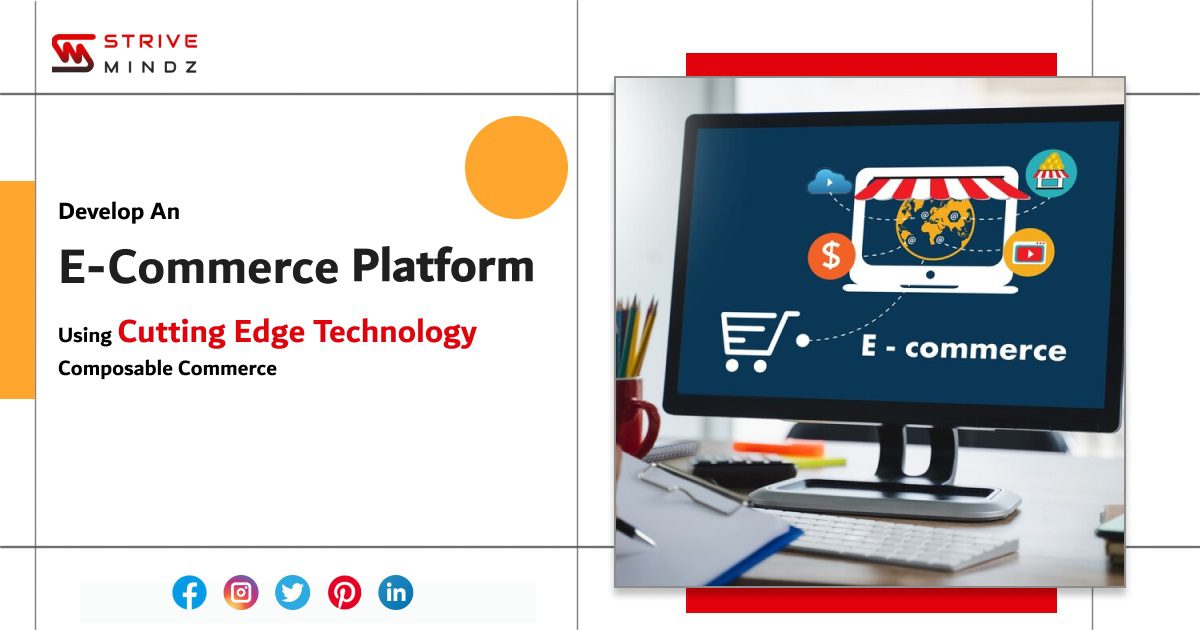Composable Commerce: What is it and why is it important in 2024?

As eCommerce and customer expectations continue to evolve, brands must choose from the best-of-breed platforms. Gartner developed a new term to describe this trend: Composable Commerce. Conventional eCommerce sites offer a standard solution from a vendor. Many people are looking for the important abilities to establish and manage an e-commerce store. Decades back, companies just entering the e-commerce field needed specialized and smooth experience, but now it’s not a big deal. So far, digital technologies are revolutionizing e-commerce like never before, traditional platforms don’t, and this turning as the primary source of digital commerce.
Old traditional e-commerce sites are behind the curve, because they stick to the original form, without changing to the current situation. Current e-commerce owners need a platform, to know customer expectations around the world and keep in touch with customers. For a number of basic reasons, such as the pandemic, push companies to the idea of shifting from the traditional one to the e-commerce site.
Moreover, there are no vendors who provide all the features, to deliver best customer experience and achieve customer demands. Due to this, several online vendors are switching to Composable Commerce. So here, we look at Composable Commerce from all angles which will help you, to determine if it is suitable for the business.
What is Composable Commerce?
Composable Commerce is a development strategy that breaks down e-commerce functionality into independent, modular components. These “building blocks,” called Packaged Business Capabilities (PBCs), can be sourced from different vendors and “composed” together to create a customized commerce platform tailored to your specific needs.
As stated in Report 2020, the term “Composable Commerce” was coined by Gartner, indicating a modular digital commerce approach. This procedure enables the selection of best-in-breed solutions for each distinctive business, that needs customized technology integration. It uses advanced technologies and strategies such as MACH (Microservices, API, Cloud, Headless) and JAM stack (JavaScript, APIs and Markup) to achieve conversion market progress. Composable Commerce has 4 basic tenets, such as:
- Modular Framework: Composable Commerce uses a quick process for the short-term to market and best experience in all details. So, each element such as a cart, CRM, payment method, etc., can be expanded freely.
- Open Ecosystem: You can apply the excellent solutions using accelerators, intermediate solutions, pre-collected solutions, and so on.
- Adaptability: You can develop your customized special stack, and provide a specially selected remarkable customer experiences for your customers.
- Business Centricity: Business users can make changes in their digital strategy, as well, enables to develop new business models and unique customer experiences with low accidental effects.
Why Choose Composable Commerce?
Traditional, monolithic commerce platforms often lack flexibility and struggle to adapt to changing business needs. Composable Commerce offers several advantages:
- Flexibility and Scalability: Easily add new features or swap functionalities based on evolving requirements.
- Personalization and Customer Experience: Create unique, tailored experiences for your customers with personalized content and offerings.
- Faster Time to Market: Get your e-commerce platform up and running faster with pre-built, readily available components.
- Cost-Effectiveness: Choose cost-efficient solutions for specific needs rather than paying for all-inclusive, yet potentially unused, features in a monolithic platform.
What are the Advantages of Using Composable Commerce?

In line with the evolution of digital technology, owners need to find paths to update the business to meet the customer’s changing expectations and needs. Also, since the covid-19 pandemic, the e-commerce sector is constantly surging than ever before. Recently, acquiring customer is the greatest difficulty found in e-commerce.
The exponents of Composable Commerce state that, using this approach to business enables swiftness, and you can deliver better customer experiences and stand out from competitors.
Built Your Own Customized Experiences
In its statement, Gartner centralized the factor of customer experience. Current e-commerce industry has numerous interfaces such as shop, online, social pages, marketplaces, IoT device and so on. Customers have been quite collaborating with brands more recently than ever before.
Today’s customers are quite different, because they chase brand or person, and completely varies from displaying ads The buying experience commenced from browsing a few years back, but now, from social media platforms, through content, ads, and some starts from the search.
Taking all these components and developing the customer experience requires more adaptive capability, but this is not the case at the beginning of the e-commerce industry. 60% of customers are loyal to the brand providing the best customer experience, which adds value to providing additional customization.
Acts Quickly to The Changing Business Requests
At the onset of the covid pandemic, the entire world was closed to homes and many shop owners were baffled, but few were equipped with the changing expectations of customers at the time.
Even in the curb, some stores offered online shopping, pick up-in-store or sidewalk pickup options to avoid close contact and they turned a profit. Meanwhile, the pick-up-in-store has increased by almost 195%. Using this procedure is quite complex, but it can be a huge problem in monolithic system. This approach also enables you to handle the questioning process without complicating other modules of your e-commerce system.
Lessens the Customer Acquisition Cost
The growth of customer acquisition cost has two important components, rising advertising platforms and changing customers insights and expectations. Relying on paid advertisements is not a standard option. Thus, to show a modular approach to the technology stack, many companies have found a way to used content or experience-led commerce methods. Eventually, two key techniques have been used to reduce the customer acquisition cost by publishing developed content on your site and enhancing the overall digital experience.
Eliminate Vendor Blockage
Monolithic traditional software lessens the adaptive capacity of the client. Even if you find the best product from another company, you will have to remain until the contract expires or spend extra to move. But you can switch components in and out, in a modular build, while it is apt for your business.
What are the Drawbacks of Employing Composable Commerce?
Even though the Composable Commerce approach have more advantages, some companies are not choosing this path. As certain elements making the obstacles for the companies to choose this path. Let’s see in detail.
-
Handling Abundant Vendors
You only need to communicate with the seller in the monolithic software, which prevents you from spending your time. Subscription processes, negotiating terms, T&C, and software integration require more time for 40-50 vendors, than a few.
-
Requirement of High Digital Experiences
Compact business is quite complex, requires more time, and is costly, to fulfil customer request. Moreover, it needs of better experience for multi functional collaboration between sophisticated developers.
-
Requirement of Special Monitoring Equipment
Infrastructure changes when shifting to a microservices architecture and certain tools are required to manage those unique microservices. This kind of transformation will be necessary, as well as, elements in the total ownership cost.
Top Composable Commerce Solutions
Elastic Path
Elastic Path is a leading Composable Commerce solution known for its flexibility and scalability. Offers a robust commerce engine with extensive customization options and a flexible API.
- Key Features: Elastic Path offers a wide range of features, including flexible catalog management, advanced pricing and promotion capabilities, and robust order management.
- Pricing Model: Pricing for Elastic Path is based on a subscription model, with pricing tailored to the specific needs of each business.
Moltin
Moltin is a popular Composable Commerce solution known for its ease of use and flexibility. A headless commerce platform ideal for building custom storefronts with a focus on developer experience.
- Key Features: Moltin offers a headless commerce architecture, allowing businesses to easily integrate with third-party systems and applications.
- Pricing Model: Moltin offers a range of pricing plans, including a free plan for small businesses and a custom plan for larger enterprises.
Commercetools
Commercetools is a leading Composable Commerce solution known for its scalability and extensibility. Provides a modular, API-first platform with scalability and a wide
- Key Features: commercetools offers a flexible API-driven architecture, enabling businesses to easily customize and extend their commerce experiences.
- Pricing Model: Pricing for commercetools is based on a usage-based model, with pricing determined by the volume of transactions and the number of API calls.
Reaction Commerce
Reaction Commerce is an open-source Composable Commerce solution known for its flexibility and community support. An open-source, GraphQL-based platform known for its flexibility and developer community.
- Key Features: Reaction Commerce offers a modular architecture, allowing businesses to easily add or remove components as needed.
- Pricing Model: Reaction Commerce is free to use, with optional paid support and hosting services available.
Read also: Benefits of Outsourcing Software Development
Use Cases and Case Studies
Real-World Examples
- Elastic Path: Elastic Path has been used by leading brands such as Tesla and T-Mobile to create highly personalized commerce experiences.
- Moltin: Moltin has been used by companies like Coca-Cola and Unilever to create seamless commerce experiences across multiple channels.
- commercetools: commercetools has been used by companies like Audi and Bang & Olufsen to create scalable and flexible commerce experiences.
- Reaction Commerce: Reaction Commerce has been used by companies like IBM and Bacardi to create innovative commerce experiences that drive customer engagement.
Industries Benefiting
- Elastic Path: Elastic Path is well-suited for industries such as retail, telecommunications, and automotive, where personalized experiences are key.
- Moltin: Moltin is ideal for industries such as consumer goods, fashion, and electronics, where seamless omnichannel experiences are critical.
- commercetools: commercetools is well-suited for industries such as manufacturing, healthcare, and travel, where scalability and flexibility are paramount.
- Reaction Commerce: Reaction Commerce is ideal for industries such as technology, food and beverage, and home goods, where innovation and agility are key.
How to Choose the Right Solution
Choosing the right Composable Commerce solution is crucial for the success of your business. Here are some key factors to consider:
- Business Needs and Goals: Start by identifying your specific business needs and goals. Consider factors such as the size of your business, target market, and growth projections. Choose a solution that aligns with your long-term business objectives.
- Scalability and Flexibility: Look for a solution that can scale with your business as it grows. Ensure that the platform is flexible enough to adapt to changing market conditions and customer demands.
- Integration Capabilities: Consider the integration capabilities of the solution. Choose a platform that can easily integrate with your existing systems and third-party applications. This will help streamline your operations and improve efficiency.
- Customization Options: Evaluate the customization options offered by the solution. Choose a platform that allows you to customize the user interface, workflows, and business rules to meet your specific requirements.
- Cost and ROI: Consider the total cost of ownership (TCO) of the solution, including implementation, maintenance, and support costs. Evaluate the potential return on investment (ROI) and choose a solution that offers the best value for your business.
- Security and Compliance: Ensure that the solution complies with industry standards and regulations. Look for features such as data encryption, secure payment processing, and compliance certifications to protect your business and customer data.
- Support and Training: Consider the level of support and training offered by the solution provider. Choose a platform that provides comprehensive support services and training resources to help you maximize the benefits of the solution.
- User Experience: Evaluate the user experience of the platform. Choose a solution that is intuitive and easy to use for both your team and your customers. A positive user experience can lead to higher adoption rates and customer satisfaction.
By considering these factors and carefully evaluating your options, you can choose the right Composable Commerce solution for your business.
Executing a Composable Commerce Solutions
Although re-platform operation requires substantial degree of time and effort, it does have some great features. Moreover, you can eliminate monolith dependence by gradually shifting from monolith to Composable Commerce. Using this approach, you can determine which functionality needs to be reformed at first and decide the appropriate time, to shift entire system from monolith to the microservice.
Strivemindz, as a leading eCommerce development company, we have experienced developers with in-depth insight into all types of industrial verticals and niches, to provide best e-commerce site. In case, you want to renovate your store through Composable Commerce solutions, contact us, to get the best reliable performance for your e-commerce store.
Final Thoughts
Composable Commerce offers a revolutionary approach to e-commerce, providing unmatched flexibility, scalability, and customization options. By choosing the right Composable Commerce solution, businesses can create highly personalized and engaging commerce experiences that drive customer loyalty and retention. With a wide range of solutions available, businesses can find the perfect fit for their unique needs and requirements.

